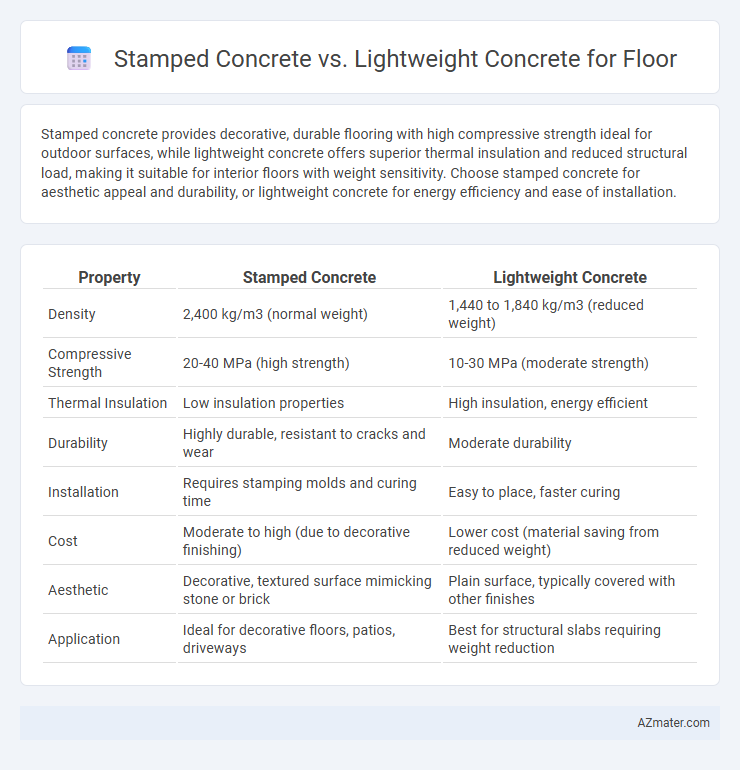Stamped concrete provides decorative, durable flooring with high compressive strength ideal for outdoor surfaces, while lightweight concrete offers superior thermal insulation and reduced structural load, making it suitable for interior floors with weight sensitivity. Choose stamped concrete for aesthetic appeal and durability, or lightweight concrete for energy efficiency and ease of installation.
Table of Comparison
| Property | Stamped Concrete | Lightweight Concrete |
|---|---|---|
| Density | 2,400 kg/m3 (normal weight) | 1,440 to 1,840 kg/m3 (reduced weight) |
| Compressive Strength | 20-40 MPa (high strength) | 10-30 MPa (moderate strength) |
| Thermal Insulation | Low insulation properties | High insulation, energy efficient |
| Durability | Highly durable, resistant to cracks and wear | Moderate durability |
| Installation | Requires stamping molds and curing time | Easy to place, faster curing |
| Cost | Moderate to high (due to decorative finishing) | Lower cost (material saving from reduced weight) |
| Aesthetic | Decorative, textured surface mimicking stone or brick | Plain surface, typically covered with other finishes |
| Application | Ideal for decorative floors, patios, driveways | Best for structural slabs requiring weight reduction |
Introduction to Stamped Concrete and Lightweight Concrete
Stamped concrete is a decorative flooring option that mimics the appearance of natural materials like stone, brick, or wood through patterned molds and color additives, offering durability and aesthetic appeal for residential and commercial spaces. Lightweight concrete consists of lightweight aggregates such as expanded clay, shale, or pumice, resulting in reduced density and improved thermal insulation, making it suitable for flooring where weight reduction is critical. Both materials provide distinct advantages, with stamped concrete excelling in design flexibility and surface texture, while lightweight concrete prioritizes structural efficiency and insulation properties.
Composition and Materials Used
Stamped concrete consists of a mixture of cement, sand, gravel, and water combined with color hardeners and release agents to create textured, decorative surfaces resembling stone or brick. Lightweight concrete incorporates lightweight aggregates such as expanded clay, shale, or pumice, reducing density while maintaining strength, often accompanied by cement and fine aggregates. The choice of materials in stamped concrete emphasizes aesthetic customization and durability, whereas lightweight concrete focuses on reduced weight and enhanced thermal insulation properties.
Installation Process Comparison
Stamped concrete installation involves pouring a slab followed by imprinting patterns and textures while the concrete is still pliable, requiring skilled labor to achieve detailed designs and proper color application. Lightweight concrete installation typically requires specialized mixing to ensure correct density and strength, with careful placement and curing practices to prevent cracking and maintain insulation properties. Both methods demand precise timing and environmental controls but differ significantly in equipment needs and surface finishing techniques.
Durability and Strength Differences
Stamped concrete offers superior durability due to its dense composition and surface treatments, making it highly resistant to wear, abrasions, and weather conditions. Lightweight concrete, while possessing good compressive strength, generally exhibits lower durability compared to stamped concrete because of its higher porosity and reduced density. The strength of stamped concrete typically ranges from 4,000 to 5,000 psi, surpassing lightweight concrete's average strength of 2,500 to 4,000 psi, which influences their suitability for high-traffic flooring applications.
Aesthetic Options and Design Flexibility
Stamped concrete offers extensive aesthetic options with its ability to mimic natural stone, brick, or wood through various patterns, colors, and textures, providing high design flexibility for customized floor finishes. Lightweight concrete, while structurally advantageous due to its reduced weight, generally offers limited surface design versatility and often requires additional treatments or overlays to achieve desired aesthetic effects. The choice between the two depends on the balance between structural needs and the desired decorative appeal for flooring projects.
Cost and Budget Considerations
Stamped concrete typically involves higher initial costs due to detailed surface preparation and decorative stamping processes, making it a premium choice for flooring. Lightweight concrete generally offers more budget-friendly pricing because of its reduced material weight and simpler installation methods, which lower labor and transportation expenses. When balancing cost and aesthetic appeal, lightweight concrete suits projects prioritizing affordability, while stamped concrete serves those investing in durable, visually appealing floor surfaces.
Maintenance Requirements
Stamped concrete requires regular sealing every 2-3 years to prevent cracking and surface wear, with occasional cleaning to remove dirt and stains. Lightweight concrete demands minimal maintenance due to its inherent durability and resistance to moisture, only needing periodic cleaning and inspections for structural integrity. Both options benefit from proactive sealing and routine care to extend floor longevity and maintain appearance.
Applications and Suitable Environments
Stamped concrete excels in decorative flooring applications such as patios, walkways, and commercial entrances, where aesthetic appeal and durability are paramount. Lightweight concrete, with its superior thermal insulation and reduced load-bearing weight, suits environments like high-rise buildings, roof decks, and cold climates requiring enhanced energy efficiency. Both materials offer distinct advantages: stamped concrete for visual impact and wear resistance, lightweight concrete for structural efficiency and thermal performance.
Environmental Impact and Sustainability
Stamped concrete often involves higher cement content and energy-intensive processes, resulting in greater carbon emissions compared to lightweight concrete, which incorporates recycled materials such as fly ash or expanded shale, reducing environmental impact. Lightweight concrete enhances thermal insulation and reduces overall building weight, contributing to energy efficiency and lower transportation emissions. Selecting lightweight concrete over stamped concrete supports sustainable construction practices by minimizing carbon footprint and promoting resource conservation.
Which Concrete Type Is Best for Your Floor?
Stamped concrete offers superior aesthetic appeal with customizable patterns and textures that mimic natural stone or wood, making it ideal for decorative flooring in patios or driveways. Lightweight concrete provides excellent thermal insulation and reduced weight, which benefits structural floors requiring lower load-bearing capacity and improved energy efficiency. Choosing between stamped and lightweight concrete depends on whether visual design or structural performance and insulation are the primary flooring priorities.

Infographic: Stamped concrete vs Lightweight concrete for Floor
 azmater.com
azmater.com